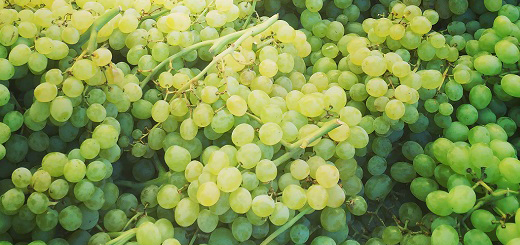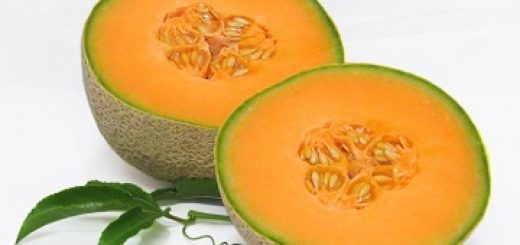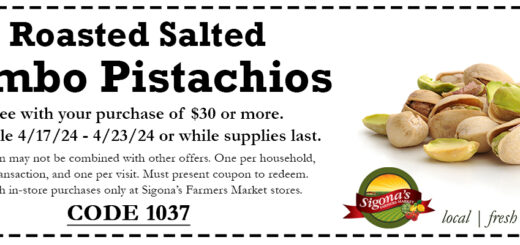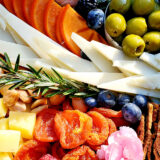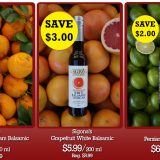Have your pumpkin and eat it too!
Have your pumpkin and eat it too!
While most pumpkin-like squash are perfect for decoration, they also make a delicious dish.
By Robbie Sigona
California produces a lot of pumpkins, and we hold plenty of pumpkin contests and festivals to prove it. Did you make it to the Half Moon Bay 41st annual Pumpkin Art and Pumpkin Festival last weekend? It’s  always such a fun time of year. If you made it, did you see the winner of the pumpkin weigh-in? The gargantuan, California-grown gourd weighed in at 1,704 pounds; now that’s a huge pumpkin!
always such a fun time of year. If you made it, did you see the winner of the pumpkin weigh-in? The gargantuan, California-grown gourd weighed in at 1,704 pounds; now that’s a huge pumpkin!
Our store is chock-full of locally grown, festive squash and gourds, with the majority coming from Spina Farms in Morgan Hill. We’ve worked with the Spina family, three generations strong, for more than 35 years to provide you with locally grown corn and many, many different heirloom and unique winter squash.
While the scalloped, bumpy and colorful squash will give your front porch a bit more curb appeal, don’t forget there is more to pumpkins and squash than meets the eye. Have you have ever selected a squash to exercise your creative cookery muscles?
From pies and breads, to soups and curries, the pumpkin-shaped winter squash we carry make delicious dishes. They’re also low in fat, low in calories and loaded with the antioxidant beta-carotene (the golden-orange-colored flesh is a dead giveaway), which is converted to vitamin A in the body to help prevent degenerative disease. Vitamin A also helps refresh hair and skin.
Pumpkin seeds also make a nice treat when roasted and tossed with different spices. Some varieties have thicker seeds, which are edible too, just more to chew. Check out some of our pumpkin recipes!
One of my favorite edible and decorative winter squash varieties is the Long Island Cheese. It’s named as such because its squatty shape and tan, buffed color makes it look like, well, a wheel of cheese! It has a slightly sweet, deep orange flesh and it tastes very much like a butternut squash and is best known for making a great pumpkin pie.
I love the look of the deeply ribbed blue-gray Jarrahdale, an heirloom variety that originated in Australia. It has very thick skin (so it stores well) with a hearty layer of golden flesh that is easily substituted for pumpkin in most recipes…just get your sharpest knife and be careful cutting through the skin.
Here are a few more of the pumpkin-like squash we carry this time of year. They’re all great for carving, of course, too – carve up a white or Jarrahdale and you just might be the talk of your block!
 Sugar Pie pumpkin is one of the meatiest with a small seed cavity and thick walls. One guess as to what it’s best for. Check for context clues. Yep – pumpkin pie!
Sugar Pie pumpkin is one of the meatiest with a small seed cavity and thick walls. One guess as to what it’s best for. Check for context clues. Yep – pumpkin pie!
–
–
–
The Turban squash might seem best for fall decorating, with its bumpy skin, bulbous crown-like top and festive coloring. Although it’s sure to add the perfect touch to a Halloween tablescape, it’s also delicious to eat. Try this recipe for Turban Squash Soup — you can use the fatter part of the squash as a soup tureen!
–
–
 Long Island Cheese is named as such because its squatty shape and tan buffed color makes it look like, well, a wheel of cheese! It has a slightly sweet, deep orange flesh and it tastes very much like a butternut squash and is best known for making a great pumpkin pie.–
Long Island Cheese is named as such because its squatty shape and tan buffed color makes it look like, well, a wheel of cheese! It has a slightly sweet, deep orange flesh and it tastes very much like a butternut squash and is best known for making a great pumpkin pie.–
–
–
 Howden pumpkins are best for carving. This was the industry standard for about twenty years and is most commonly grown for jack-o-lanterns. This variety has thinner skin with a large cavity filled with many seeds. It’s not ideal for pie, but is nice mashed and served as a side dish.
Howden pumpkins are best for carving. This was the industry standard for about twenty years and is most commonly grown for jack-o-lanterns. This variety has thinner skin with a large cavity filled with many seeds. It’s not ideal for pie, but is nice mashed and served as a side dish.
—
–
–
 Cinderella squash are large with a deep orange color. If fairy godmothers did exist, the Cinderella squash would be just the thingamabob we’d want turned into a coach to take us to the royal ball. It’s edible, but not usually eaten.–
Cinderella squash are large with a deep orange color. If fairy godmothers did exist, the Cinderella squash would be just the thingamabob we’d want turned into a coach to take us to the royal ball. It’s edible, but not usually eaten.–
–
–
–
 The Jarrahdale is an heirloom that originated in Australia. It’s deeply ribbed with an enchanting, almost ghostly blue-gray skin. Jarrahdales have very thick skin (so they store well. For months, even) with a hearty layer of golden flesh that is easily substituted for pumpkin in most recipes.–
The Jarrahdale is an heirloom that originated in Australia. It’s deeply ribbed with an enchanting, almost ghostly blue-gray skin. Jarrahdales have very thick skin (so they store well. For months, even) with a hearty layer of golden flesh that is easily substituted for pumpkin in most recipes.–
–
–
 The One Too Many (a.k.a. the Bloodshot Eyeball) is an orange and cream striped pumpkin that comes in many different shapes in sizes: some are oblong, some are round. This variety also makes tasty pies.–
The One Too Many (a.k.a. the Bloodshot Eyeball) is an orange and cream striped pumpkin that comes in many different shapes in sizes: some are oblong, some are round. This variety also makes tasty pies.–
–
–
 The Red Kuri is a small, teardrop shaped squash has a flavorful, nutty flavor (some say it’s similar to the flavor of chestnuts). You may also know it as Hubbard, Hokkaido pumpkin or uchiki kuri squash.–
The Red Kuri is a small, teardrop shaped squash has a flavorful, nutty flavor (some say it’s similar to the flavor of chestnuts). You may also know it as Hubbard, Hokkaido pumpkin or uchiki kuri squash.–
–
–
 While the white pumpkin is great for carving or painting, it can also be substituted for an orange pumpkin in any recipe. The flesh is light golden and it has large seeds that are perfect for toasting. It has a thick flesh that has a good texture for baking.
While the white pumpkin is great for carving or painting, it can also be substituted for an orange pumpkin in any recipe. The flesh is light golden and it has large seeds that are perfect for toasting. It has a thick flesh that has a good texture for baking.



